PUZZLE RULES
OVERVIEW OF PUZZLE RULES
| BINAIRO | HITORI | KAKURASU | KAKURO |
| KNOSSOS | KUROMASU | LIGHT UP | NURIKABE |
| SLITHERLINK | SUGURU | SUGURULINES |
BINAIRO RULES
Binairo also known as takuzu or binairy puzzle is played on a rectangular grid. The goal is to fill in the grid with digits 0 and 1. Similar to many other puzzle each takuzu begins with several squares in the grid already filled. Use the following rules to fill the grid:
- More than two of the same digits can't be adjacent. So xxx11x becomes xx0110 and likewise x0x0xx → x010xx.
- Each row and column must have an equal number of 0s and 1s. So 0xx010 becomes 011010. Or one more for odd sized grids.
- Each row and column is unique (100101 & 1001xx becomes 100101 & 100110.
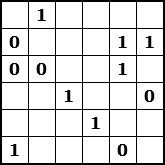
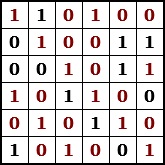
HITORI RULES

Hitori (Japanese for "leave me alone" or "one person") is a logic puzzle published by Nikoli. This puzzle has a grid of cells with each containing a number. Hitori is played by eliminating numbers by making them black.
Make sure all three following rules are true:
- No row or column can have the same number twice.
- Black cells may only connect diagonally.
- The remaining numbers must be all connected to each other horizontally or vertically.
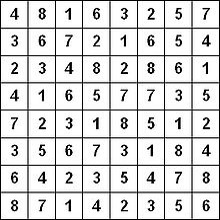
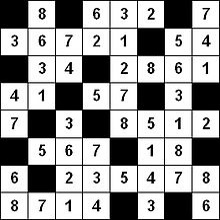
KAKURASU RULES

Kakurasu is essentially a Latin square with addition. This puzzle is played on a rectangular grid. The goal is to color some cells to satisfy the clues around the grid.
- The numbers at the top and at the left are the values for each of the squares in the rows and columns (example: the first square in a row or column is worth 1).
- The numbers at the bottom and at the right equal the row and column totals for the colored squares.
Coloring a square will add that square's value to both the row's total and the column's total.
There is only one solution for each puzzle. Use logic. You never need to guess!
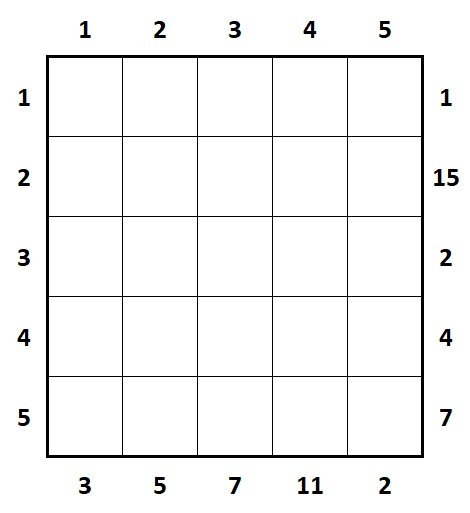
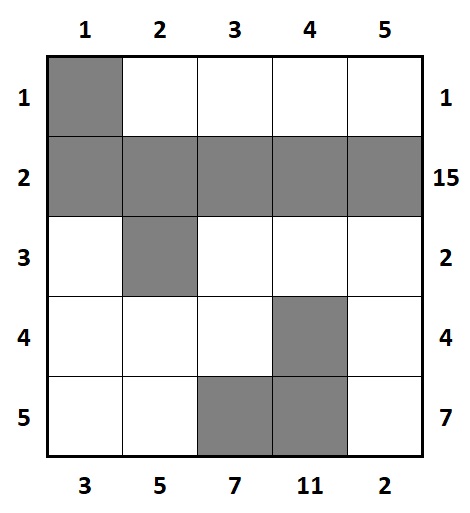
KAKURO RULES

Kakuro, also known as Cross Sums or Kakro is a mathematical puzzle. Some dark cells contain a diagonal slash with numbers above or under called clues. The object is to fill in numbers from 1 to 9 into the white cells to total the clue associated with it horizontal or vertical. However no numbers can be duplicated For example the clue 4 you can have 1 and 3, but not 2 and 2.
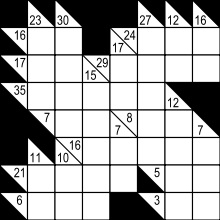
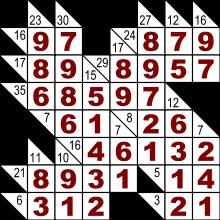
To become an advanced kakuro player check our page with kakuro techniques.
KNOSSOS PUZZLE RULES

A Knossos shows the floor plan of a palace with many rooms in dif|ferent sizes and shapes. Each number stands for 1 room and indicates the number of walls of that room.
Find the missing walls and connect the corners of a cell horizontally or vertically.
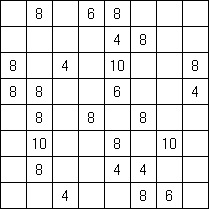
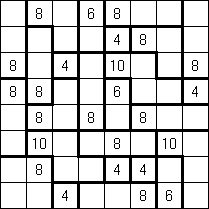
KUROMASU RULES

Kuromasu (Japanese: kurodoko) is a puzzle crated by Nikoli. You can solve this puzzle by colouring cells black or white according to the following simple rules:
- The numbers on the grid show the number of white cells from the number to the nearest black cell or to the border of the grid (horizontal and vertical).
- The cells with numbers remain white.
- Black cells only touch diagonally.
- All white cells need to be connected.
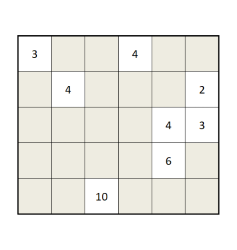
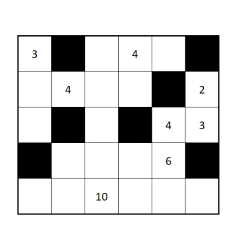
LIGHT UP RULES

Light Up (also called Akari) is a puzzle crated by Nikoli. It is played on a rectangular grid of white and black cells. The player places lights in the white cells according to the rules below:
- Place lights in the white cells until the entire grid is lit up.
- Two lights may not shine on each other.
- A light sends rays of light horizontally and vertically illuminating its entire row and column unless it is blocked by a black cell.
- A black cell may have a number on it from 0 to 4 indicating how many lights must be placed adjacent to its four sides.
- An unnumbered black cell may have any number of lights adjacent to it or none.
To make it easier you can place crosses in white cells where you are sure that lights or not allowed.
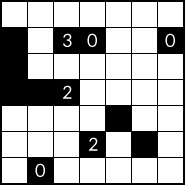
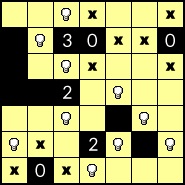
NURIKABE RULES

Nurikabe was invented by Nikoli. This puzzle has also other names including Cell Structure and Islands in the Stream.
Nurikabe is played on a rectangular grid with some cells containing numbers. Initially all cells have the same color.
The challenge is to change unnumbered cells (numbered cells cannot be changed) so that:
- Some cells get a dot and belong to an island
- Some cells become blue and belong to the sea to separate islands
Two island-cells or two sea-cells are considered connected if they are adjacent vertically or horizontally.
The goal is to connect dot-cells with numbered cells to form islands while connected blue cells form the sea. There are 3 rules to follow:
- A numbered cell is an island-cell and determines the number of cells in that island. Example: a cell with number 3 needs two dot-cells to form an island.
- Each island must have only one numbered cell.
- There is only one sea with no 2×2 areas of blue cells.
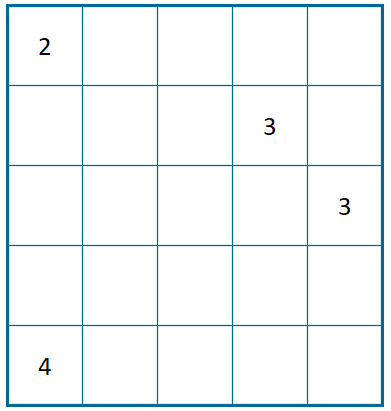
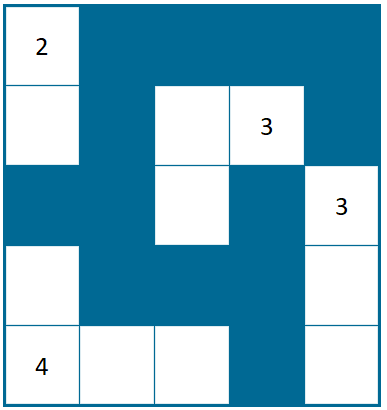
PAIRS NURIKABE
Pairs Nurikabe is a variant where each island must contain exactly two numbers instead of one. The total size is equal to the sum of these numbers.
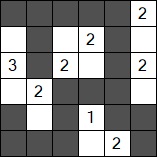
SLITHERLINK RULES

This puzzle is originally developed by Nikoli. There are many names for the puzzle such as: Fences, Takegaki puzzles, Loop the Loops, Ouroboros puzzles, Suriza and even Dotty. In a slitherlink puzzle you try to connect dots with lines following the rules below:
- Connect adjacent dots with vertical or horizontal lines and try to make one loop. Diagonal shortcuts are not allowed.
- The numbers in the cells indicate how many of its sides are part of the loop: 0, 1, 2 or 3.
- Empty cells may be surrounded by any number of lines.
- The loop may not cross itself.
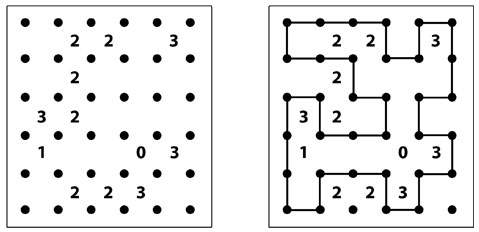
SUGURU RULES

The rules are simple, but solving a suguru puzzle can be difficult sometimes. It is very similar to the figure puzzle sudoku. A sudoku consists of 9 equal forms (= large squares) with 9 squares in which each time the numbers 1 to 9 fit.
A suguru contains different shapes with 1, 2, 3, 4 or 5 squares. Just like sudoku, some boxes have already a number. With suguru puzzles we limit ourselves to the numbers 1 to 5. Below a suguru of 3x5 and one of 5x6.
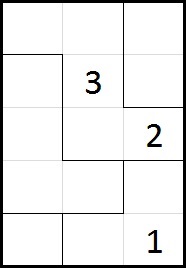
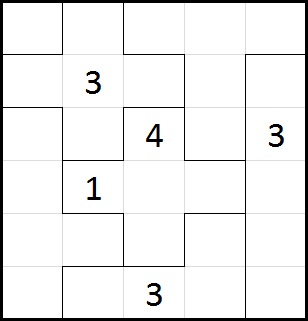
How do we proceed to solve a suguru puzzle? In the boxes you have to place a number, just like sudoku.
- The smallest form consists of only one box. Here you can only enter the number 1.
- A form with two squares always gets the numbers 1 and 2. Now you have to start thinking: where goes number 1 and where comes number 2.
- Now follow the same procedure for the shapes with 3, 4 and 5 squares.
Pay attention! Boxes with the same number must never be neighbors (neither horizontally, vertically nor diagonally). An example below. The red boxes are wrong.
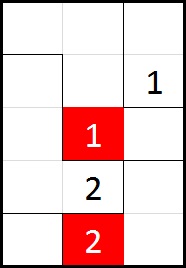
There is always only one correct solution and the boxes should always be filled in by following a logical reasoning, without guessing. It is not a gambling puzzle. It is thinking and not a matter of haphazardly trying something out. There is no fixed order to fill in the numbers.
Now we will solve, step by step, a suguru puzzle.

| This is the start of a suguru puzzle. There are already a few numbers filled in to help you on your way. |
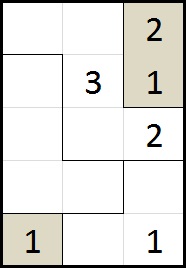
|
In the top right-hand corner there are 2 boxes. Just above the 2 (already on the grid)
you may not place another number 2. So there comes number 1 and number 2 comes above number 1.
At the bottom left you can only enter number 1. |
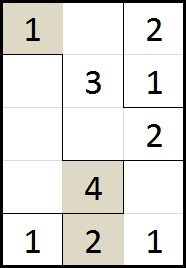
| At the top left we place 1. This is the only place where we can
avoid contact with the 1 we have placed earlier.
There is only one place at the bottom for number 2 to avoid contact with the other 2. In addition to number 4, a 3 will definitely come. So number 4 is the only option here. |
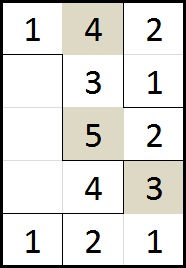
|
The 4 comes on top to prevent collision with the other 4.
There is only one place left for number 5. Also for number 3 below there is only one option. |
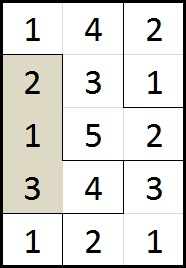
|
The last 3 digits are easy to fill in.
You are ready to dive into the suguru world. Beware! Great danger of addiction. |
Good luck with PLAY SUGURU ONLINE.
SUGURU LINES RULES

Suguru lines is based on Suguru. With suguru lines all the numbers are on the grid, but most of the lines are gone. So the sugurulines mission is to restore the lines.
Each puzzle has only one right solution. Trial and error isn't the way to solve these puzzles, but logic thinking using special solving strategies.
Let's solve a puzzle together!
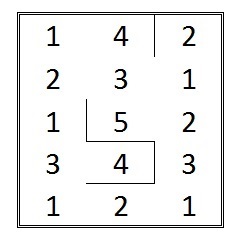
Here you see how a sugurulines puzzle looks like. It's a grif filled with numbers and there are a few lines. These lines are there to make sure that only one solution is possible.
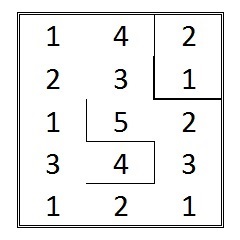
Look at number 2 in the top right corner. The number 1 under this number 2 is the only number 1 that is reachable for this number 2. So, they belong in the same group. Can we add number 3? Now we can't because that 3 belongs to another group, the group of the number 4 next to our number 2. So we've found our first group and we may draw the lines.
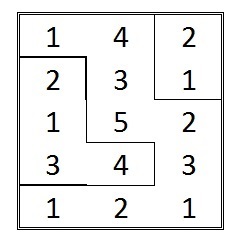
The number4 under the number 5 must add the number 3 at the left to its group. The numbers 1 and 2 above the number 3 are also part of this group. There's no number 5 that we may add. So our second group is complete, with 4 numbers. we draw the lines.
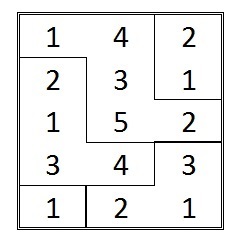
We draw a line under the number 2 at the right of number 5. We have our thrid group, one with 5 numbers. Can you smell the finish? It's clear now that the number 1 in the bottom left corner will be a group with one number.


